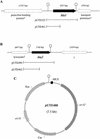Beta-lactamase genes of the penicillin-susceptible Bacillus anthracis Sterne strain
- PMID: 12533457
- PMCID: PMC142833
- DOI: 10.1128/JB.185.3.823-830.2003
Beta-lactamase genes of the penicillin-susceptible Bacillus anthracis Sterne strain
Abstract
Susceptibility to penicillin and other beta-lactam-containing compounds is a common trait of Bacillus anthracis. Beta-lactam agents, particularly penicillin, have been used worldwide to treat anthrax in humans. Nonetheless, surveys of clinical and soil-derived strains reveal penicillin G resistance in 2 to 16% of isolates tested. Bacterial resistance to beta-lactam agents is often mediated by production of one or more types of beta-lactamases that hydrolyze the beta-lactam ring, inactivating the antimicrobial agent. Here, we report the presence of two beta-lactamase (bla) genes in the penicillin-susceptible Sterne strain of B. anthracis. We identified bla1 by functional cloning with Escherichia coli. bla1 is a 927-nucleotide (nt) gene predicted to encode a protein with 93.8% identity to the type I beta-lactamase gene of Bacillus cereus. A second gene, bla2, was identified by searching the unfinished B. anthracis chromosome sequence database of The Institute for Genome Research for open reading frames (ORFs) predicted to encode beta-lactamases. We found a partial ORF predicted to encode a protein with significant similarity to the carboxy-terminal end of the type II beta-lactamase of B. cereus. DNA adjacent to the 5' end of the partial ORF was cloned using inverse PCR. bla2 is a 768-nt gene predicted to encode a protein with 92% identity to the B. cereus type II enzyme. The bla1 and bla2 genes confer ampicillin resistance to E. coli and Bacillus subtilis when cloned individually in these species. The MICs of various antimicrobial agents for the E. coli clones indicate that the two beta-lactamase genes confer different susceptibility profiles to E. coli; bla1 is a penicillinase, while bla2 appears to be a cephalosporinase. The beta-galactosidase activities of B. cereus group species harboring bla promoter-lacZ transcriptional fusions indicate that bla1 is poorly transcribed in B. anthracis, B. cereus, and B. thuringiensis. The bla2 gene is strongly expressed in B. cereus and B. thuringiensis and weakly expressed in B. anthracis. Taken together, these data indicate that the bla1 and bla2 genes of the B. anthracis Sterne strain encode functional beta-lactamases of different types, but gene expression is usually not sufficient to confer resistance to beta-lactam agents.
Figures



References
-
- Agaisse, H., M. Gominet, O. A. Okstad, A. B. Kolsto, and D. Lereclus. 1999. PlcR is a pleiotropic regulator of extracellular virulence factor gene expression in Bacillus thuringiensis. Mol. Microbiol 32:1043-1053. - PubMed
-
- Agaisse, H., and D. Lereclus. 1996. STAB-SD: a Shine-Dalgarno sequence in the 5′ untranslated region is a determinant of mRNA stability. Mol. Microbiol. 20:633-643. - PubMed
-
- Agaisse, H., and D. Lereclus. 1994. Structural and functional analysis of the promoter region involved in full expression of the cryIIIA toxin gene of Bacillus thuringiensis. Mol. Microbiol 13:97-107. - PubMed
-
- Agata, N., M. Ohta, Y. Arakawa, and M. Mori. 1995. The bceT gene of Bacillus cereus encodes an enterotoxic protein. Microbiology 141:983-988. - PubMed
-
- Arantes, O., and D. Lereclus. 1991. Construction of cloning vectors for Bacillus thuringiensis. Gene 108:115-119. - PubMed
Publication types
MeSH terms
Substances
Associated data
- Actions
- Actions
Grants and funding
LinkOut - more resources
Full Text Sources
Other Literature Sources
Research Materials

